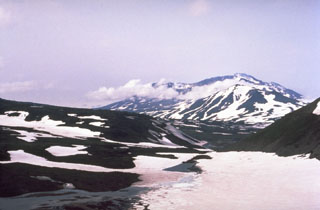Report on Gorely (Russia) — January 1985
Scientific Event Alert Network Bulletin, vol. 10, no. 1 (January 1985)
Managing Editor: Lindsay McClelland.
Gorely (Russia) Ash explosions
Please cite this report as:
Global Volcanism Program, 1985. Report on Gorely (Russia) (McClelland, L., ed.). Scientific Event Alert Network Bulletin, 10:1. Smithsonian Institution. https://doi.org/10.5479/si.GVP.SEAN198501-300070
Gorely
Russia
52.5549°N, 158.0358°E; summit elev. 1799 m
All times are local (unless otherwise noted)
Gorely began to erupt 27 December. During the initial activity, phreatic explosions ejected clouds that rose to 3.5 km height. Ash explosions began 30 December, producing plumes that reached 3 km height and extended 100 km E. The eruption ended 8 January. In the previous eruption, June 1980-July 1981, initial phreatic activity gave way in later phases to phreatomagmatic explosions that ejected alkali-rich basaltic andesite (Kirsanov and Ozerov, 1984).
Reference. Kirsanov, I.T., and Ozerov, A.Yu., 1984, Composition of products and energy yield of the 1980-81 Gorelyi volcano eruption: Volcanology and Seismology, no. 5, p. 23-43.
Further Reference. Gavrilov, and others, 1986, Intensification of Goreli volcanic activity in August-September 1984: Volcanology and Seismology, no. 5, p. 90-92.
Geological Summary. Gorely volcano consists of five small overlapping stratovolcanoes constructed along a WNW-ESE line within a large 9 x 13 km caldera. The caldera formed about 38,000-40,000 years ago accompanied by the eruption of about 100 km3 of tephra. The massive complex includes about 40 cinder cones, some of which contain acid or freshwater crater lakes; three major rift zones cut the complex. Another Holocene stratovolcano is located on the SW flank. Activity during the Holocene was characterized by frequent mild-to-moderate explosive eruptions along with a half dozen episodes of major lava extrusion. Early Holocene explosive activity, along with lava flows filled in much of the caldera. Quiescent periods became longer between 6,000 and 2,000 years ago, after which the activity was mainly explosive. About 600-650 years ago intermittent strong explosions and lava flow effusion accompanied frequent eruptions. Historical eruptions have consisted of moderate Vulcanian and phreatic explosions.
Information Contacts: Tass.

